Reducing Trash: A Lesson for Taiwan
By Weiweoi Chen (陳芛薇)
Photos by Tzu Cheng Liu (劉子正)
Abridged and translated by Huang Yung-ping (黃永平)
Syharn Shen (沈思含)
Reducing Trash: A Lesson for Taiwan
By Weiweoi Chen (陳芛薇)
Photos by Tzu Cheng Liu (劉子正)
Abridged and translated by
Huang Yung-ping (黃永平)Syharn Shen (沈思含)
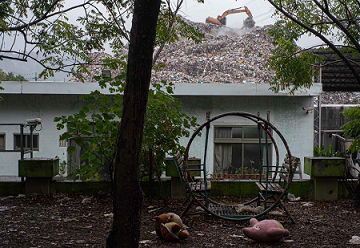
The garbage dump in Nantou's Caotun Township has been storing garbage as old as 3 years.
It was 7 o’clock on a Monday morning. By the entrance to an alley in New Taipei City, someone had already left a large bag of garbage there. Within the next hour, 2 more local residents came to the same spot to dump their bags of trash. At the sight of this, city government inspectors—previously lying in wait—came forward to stop them and tell them that litterers will be fined from 1,200 to 6,000 NTD (or around 40 to 200 USD).
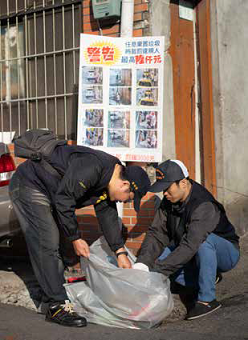
City inspectors examine a bag of garbage dumped at a spot with a warning sign for littering fines.
This location is one of the many "dirty spots" in the city where littering is common. To tackle littering at the spots, the city government has taken countermeasures such as holding regular cleanups, examining the discarded bags of garbage, installing surveillance cameras, conducting on-site inspections, and fining litterers. In 2019 alone, more than 5,000 littering fines were issued by the New Taipei City Government.
Although signs detailing fines for violators have been put up at every "dirty spot" in the city, some locals still dump their bags of garbage on the ground. As a result, city inspectors have to track litterers down one by one.
"Things are much better now. Years ago, the situation was terrible," said Qiu Rui-jia (邱瑞加), one of the city inspectors. In 2011, there were nearly 800 "dirty spots" in New Taipei City. To make the city cleaner, the local government implemented the "per-bag trash collection fee" policy, a pay-as-you-throw scheme in which residents pay waste management fees by purchasing special bags to pack and dispose of their trash. In addition, the city government focused on eliminating "dirty spots" and stopped installing new trash cans on pedestrian streets—for the bins often end up overflowed with household waste, creating new "dirty spots."
Nowadays, everyone seems to know that littering is prohibited. But back in the 1980s and early 1990s, the streets of Taiwan were littered with garbage everywhere. In Taipei City, there used to be 5,000 to 7,000 spots for garbage disposal, including public dumpsters and common spots where people would dump their garbage. “Back in those days, there were no penalties for littering because people could get rid of trash everywhere,” said Huang Kuan-chu (黃寬助), an official of Taipei City's Department of Environmental Protection (DEP).
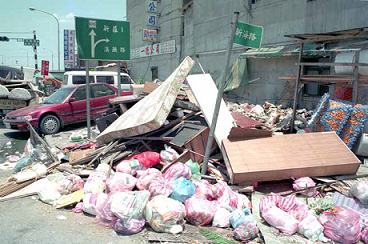
Back in the 1980s and 1990s, the streets of Taiwan were littered with garbage. (Photo provided by Central News Agency)
The Introduction of New Waste Collection Policies
Two decades ago, Taipei's economic development and population growth brought about a sharp increase in the city's generation of waste. The garbage piles on the streets leaked dirty water and reeked a terrible stench that attracted animals, rummaging through the heaps of waste as they try to feast on the discarded food scraps and leftovers in the bags. It was an unsightly condition for the capital city.
To fix the garbage problem and keep trash off the ground, Taipei City Government launched a series of waste collection measures, beginning with the withdrawal of dark green public dumpsters on the streets that led to filthy piles of garbage. Instead of throwing garbage into the dumpsters, citizens were to bring their household waste at specific times to designated locations, where garbage trucks would arrive to collect them. The city government also encouraged residents to separate trash from recyclables, and implemented in 2000 the "per-bag trash collection fee" policy that required citizens to dispose of their trash in special bags sold by the city. A few years later, the city also started collecting food waste for free.
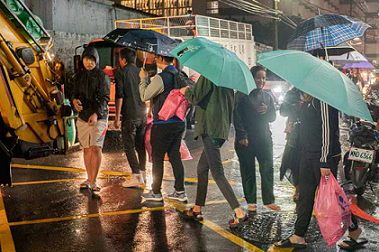
Rain or shine, taking the garbage out at specific times for trucks to collect is part of daily life in Taiwan.
“Before implementing the 'per-bag trash collection fee' policy, we held over 300 public meetings across the city, hoping that the program could reduce the amount of trash generated in the city,” expressed Li Min-hao (李旻壕), chief of Waste Treatment Division at Taipei City's DEP.
Following Taipei City's initiative in reducing trash and keeping garbage off the ground, other cities and counties in Taiwan also started to implement similar measures. Twenty years later today, taking the garbage out for trucks to collect has become part of people's daily life in Taiwan.
But compared to other cities and counties that have trucks collect garbage as they drive by the streets, Taipei is the only city in Taiwan where trucks stop at specific times and locations to collect household waste. When the trash and recycling trucks arrive at a location, Taipei City residents dispose of their trash, recyclables, and food waste accordingly, assisted by 4 waste collectors. As soon as the time slot ends, the collectors will jump on the trucks and leave for the next collection spot.
Stopping at specific times and locations allows waste collectors to make sure that waste is sorted properly. If they suspect something, they will examine a bag of trash immediately to check if any recyclables or food waste have been mixed in. This often leads to quarrels with residents, yet most waste collectors speak highly of the policy. “Back in the 1980s, the streets were full of garbage. It took us a long time to collect them and clean up. The new collection method is much better, and citizens are more cooperative now,” one of the waste collectors commented.
Taipei City's example has attracted representatives from other local governments in Taiwan, and even Indonesia and Malaysia, to come and learn about city's waste collection system.
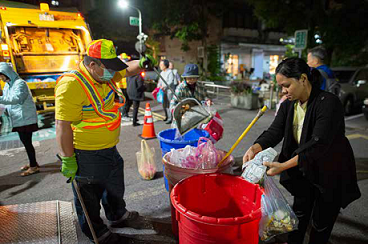
Local residents dispose of their waste under the watch of waste collectors.
With the implementation of the "per-bag trash collection fee" policy, residents that generate more trash have to pay more, so people are motivated to sort their waste and decrease the use of disposable products. This policy cut back two-thirds of the trash in Taipei City, from 3,000 or 4,000 tons to 1,000 tons per day—an amount that could be fully processed by the 3 operating incinerators in the city.
New Taipei City adopted the same policy a decade later, and achieved a dramatic drop in the amount of trash as well. However, the “per-bag trash collection fee" policy became a success due to the dense population and abundance of resources in Taipei and New Taipei City. The same practice might not be readily applicable to other places in Taiwan.
Waste Collection in Taiwan's Rural Areas
At a garbage dump ten stories high, tens of millions of bags of trash are piled here. The once bright colors of the trash bags have faded with constant exposure to rain and sunlight. Standing before the trash mountain, I hold my breath but cannot stop the foul stench from making me feel sick. This is the temporary dumping ground of Nantou County's Caotun Township in central Taiwan. The garbage piled here are nearly 3 years old.
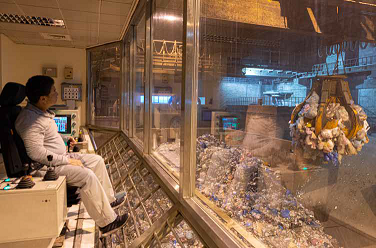
A staff of Taipei's Beitou Refuse Incineration Plant operates a machine to process waste. Taiwan's incinerators work around the clock to process 95% of all the waste generated by residents.
Of all the trash generated in Taiwan, 95% are burnt in 24 incinerators spread across the island. In most cases, trash is directly transported to local incinerators after collection. But for counties like Nantou with no incinerators, piles of trash are stored at temporary dumps before shipping them to incinerator plants in other counties. This waste management process has been running smoothly for the past 2 decades, but in recent years, many counties with incinerators have cut back on the amount they burn for other counties.
In Nantou County, of its 250 tons of trash generated every day, only 100 to 150 tons are now sent away to incinerators in other counties, leaving at least 100 tons of trash piling up every day at local garbage dumps. And compared to other townships with no storage space, Nantou's Caotun Township has a relatively spacious dump in the countryside. So, past 3 years, more garbage has been brought in than sent away.
“It’s dreadful, isn’t it? I mean the waste we produce as humans,” said the person who guided us to Caotun's garbage dump. It was dreadful indeed. Not to mention that the trash mountain was only generated by a town with less than 100,000 residents. What would the amount of trash generated by Taiwan's 23 million people look like? Standing before the dump, I started to have a better grasp of the following piece of information—in 2018, each person in Taiwan produced an average of 183 kilos of waste.
Seeing the garbage at the dump pile higher and higher, local waste collectors are increasingly concerned. But when the waste collection time arrives, they still perform their duties by bringing more garbage back to the dump. For if they don’t, the streets of Nantou might be full of garbage again.
Other places with no operating incinerators also face the same problem, such as Yunlin County, Xinzhu County, and Taiwan’s offshore islands. Furthermore, the existing plants that have been operating for one or two decades are becoming old, with their capacities decreasing. If the amount of trash is not reduced, counties with incinerators may also face piled up garbage with no place to go. “We have already reduced Nantou’s trash from 330 tons to 250 tons, but the central government want us to cut down to 230 tons, which is very difficult,” the chief of the Waste Management Section at Nantou County’s Environmental Protection Bureau Wu Pei-juan (吳佩娟) expressed.
How can counties in Taiwan reduce their amount of trash? Taipei’s “per-bag trash collection fee" policy as a potential solution is at the center of much discussion.
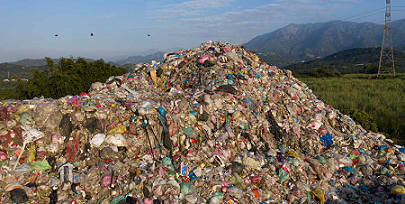
In Gukeng Township of Yunlin County, one of the counties without incinerators, thousands of tons of garbage have been piled up at the local dump.
Taipei’s Policy: Applicable to Other Places in Taiwan?
When Taipei City Government introduced the “per-bag trash collection fee" policy in 2000, there were many issues at the beginning. Many residents simply littered their garbage, and there was a proliferation of counterfeit bags. Nonetheless, the policy did more good than harm over the 20 years since its implementation, reducing two-thirds of the trash in Taipei City.
Currently, apart from 3 places in Taiwan that collect trash fees by the bag—Taipei City, New Taipei City, and a district in Taichung City—other cities and counties in Taiwan charge trash fees along with water bills, a practice of many years. In this system, households that use more water pay more trash fees. But there is really no connection between water usage and waste generation, so there is a lack of incentive for people to cut back on their trash.
Since the “per-bag trash collection fee" policy achieved great results in Taipei, Taiwan's Environmental Protection Administration (EPA) wanted to replicate the model in other cities and counties, but without success. One reason is the concern that people might refuse to pay for the special bags and just dump their garbage in the wilderness instead. “In the countryside, there are plenty of ways to get rid of your trash. One can bury them underground, burn them, or dump them in remote areas. It'd be hard for us to catch them,” the head of Nantou's waste collecting team He Xiao-long (何曉龍) explained.
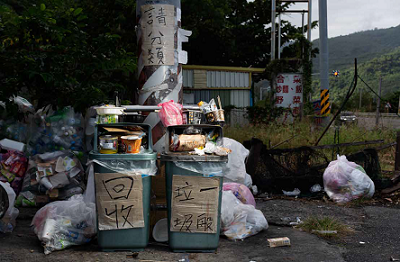
Overflowing trash and recyclable bins on a street show heaps of garbage that has not been sorted properly.
Another reason, and perhaps a more important one, is the fact that collecting trash fees by the bag will considerably decrease the local governments' income to process waste. For the general public to adopt the practice and buy the special bags, the selling price of a bag has to be low and affordable. But, the income from selling bags will be far lower than the actual expenses of processing waste.
Taking Taipei City for example, the city's income from trash fees lowered by about two-thirds after the city started collecting trash fees by the bag. The decrease in income keeps many local governments from carrying out the policy. In addition, implementing the policy will create new costs. "There will be costs for the production and sale of the bags as well as administrative costs for carrying out the policy. And these costs will always be there," explained an official of Kinmen County's Environmental Protection Bureau. His comment points to the fact that local governments don’t have the same financial resources as special municipalities in Taiwan.
When considering a nation-wide implementation of collecting trash fees by the bag, South Korea is a good example. With a bigger population and a larger territory than Taiwan, South Korea might face more challenges in implementing the policy, but the government managed to carry it out countrywide since 1995. In the rural areas, public dumpsters were set up instead, with trash fees charged by the household. As a result, South Korea's waste was reduced by 40%, Seoul no longer needed to build a new incineration plant, and the country's recycling businesses thrived. Herlin Hsieh (謝和霖), secretary-general of sustainability nonprofit Taiwan Watch Institute, noted that South Korea's adequate reporting and surveillance mechanism prevents citizens from littering, reduces waste generation, and keeps their streets clean.
Whether it is Taipei City or South Korea, the success of collecting trash fees by the bag lies in its effectiveness in reducing trash, a goal that Taiwan still needs to strive for.
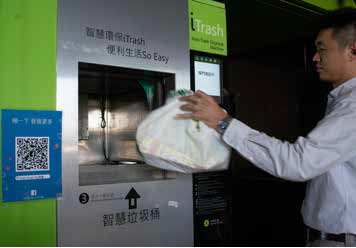
iTrash smart garbage bins charge trash fees by the weight, which creates incentives to sort waste and recycle.
Effective Waste Collection Methods that Reduce Trash
In addition to generating less trash at the source, separating recyclable materials and food waste are also important keys to reducing trash, so an effective waste collection method is needed. However, waste collection methods vary greatly between Taiwan's urban and rural areas, with much room for improvement.
Over the past few decades, people in Taiwan have been taking the trash out for trucks to collect at specific times and locations, sacrificing convenience for a cleaner environment. According to a survey on 2,000 residents in Taipei City and New Taipei City conducted by the Industrial Technology Research Institute, 75% expressed that the designated waste collection time was not convenient for them.
To make garbage disposal more convenient for the public, Hao-Yang Environment Technology developed smart garbage bins called iTrash for people to dispose of their garbage at any hour. iTrash collects trash, recyclables, and food waste. Trash fees are charged by weight, and users can earn rewards by recycling. As iTrash's bins only open after users insert a smartcard, they can prevent the overflow or pile up of garbage. “We installed iTrash bins on a street in Taipei for trial period of a few months. Much to our surprise, not a single bag of garbage was found near them,” said Liu Han-yu (劉涵宇), deputy CEO of Hao-Yang Environment Technology.
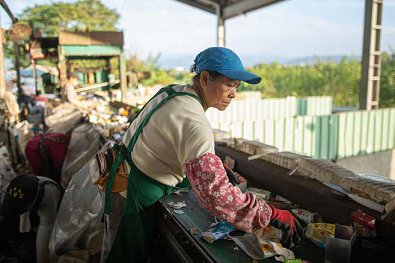
A staff at Caotun's garbage dump in Nantou County sorts recyclables by hand.
"Before, when we collected trash in communities, we noticed that if we charged every household the same amount of trash fees, many residents wouldn't sort their waste or separate recyclables, resulting in larger amounts of trash. So, we came up with a system that charges trash fees by the weight, which is fair and also convenient for people to dispose of their garbage," Liu added. Hao-Yang Environment Technology is collaborating with Taipei City to install more iTrash bins in the city.
In Taipei, citizens sort recyclables before disposing them, so different types of recyclables can be sent directly to private contractors for further processing. But in Nantou County, recyclable materials are often not sorted beforehand. At Caotun's garbage dump, there is a mound of recyclables waiting to be sorted. The recyclables are loaded onto a conveyor belt lined with staff busy sorting papers, cans, and other recyclables by hand. As fast as the staff work, their speed will never catch up with the pace in which recyclables are generated and brought in. “If we could adopt Taipei's system that collects different recyclables on separate days, or have recycling trucks collect recyclables on all routes every day, things would be so much better,” the head of Caotun's waste collection team Xu Guo-qing (徐國慶) said.
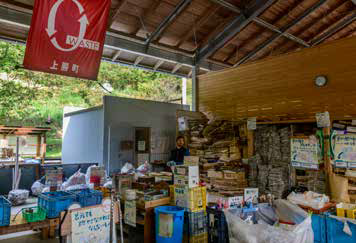
In Japan's zero-waste town of Kamikatsu, locals sort their waste into 45 different categories. (Photo by Alberto Buzzola)
The differences in waste collection methods between urban and rural areas show a gap in resources, as reflected in the number of waste collecting trucks and staff members. Taipei City has an abundance of financial resources and labor force, but rural areas such as Nantou County lack both.
Collection methods also vary according to local circumstances. For instance, collecting waste at specific times and locations is suitable for urban areas that are densely populated, but not for remote areas with few residents. In Taiwan's mountain areas, dumpsters are usually installed for residents to dump their garbage, which will be collected by waste collectors regularly. But without on-site inspection and monitoring, people often dump all of their garbage without sorting—resulting in more trash and more trouble for the waste collectors.
For effective waste collection in the rural areas, Japan's zero-waste town of Kamikatsu serves as an exemplary model. With a stunning recycling rate of 80%, the mountain town has its 1,500 residents transport all of their trash and recyclables to the waste collection center that is managed by full-time administrators. For residents who cannot drive and bring their waste to the center, Kamikatsu's town office will collect waste from their homes once in two months.
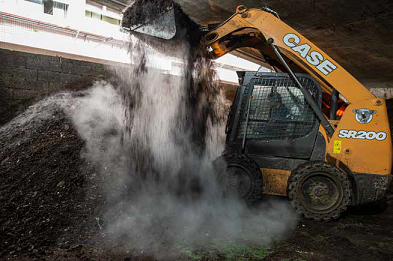
Food waste is turned into compost at an incinerator plant.
In 2016, Taiwan's EPA launched a program to build recycling stations across Taiwan's villages and communities. Similar to Kamikatsu's model, locals dispose of their recyclables at the stations and collect points that can be exchanged for merchandise. The program increased recycling rates, but its overall effectiveness is limited because the station only collects recyclables, not trash. Hsieh, a long-time advocate of the recycling stations, hopes that trash can be disposed of at the stations. He also suggests that the stations be staffed with administrators who can guide and inform the public on how to sort waste.
Waste Management: A Responsibility of All
As more and more waste is generated and accumulated over the years, it is critical for Taiwan to develop waste collection methods that are convenient for people to dispose of their garbage and that can effectively reduce the amount of trash.
Since 2005, Taiwan's EPA started to implement a program that required the public to sort waste into trash, recyclables, and food waste. Over the years, the amount of trash generated per capita decreased, and Taiwan's recycling rate reached 60% in 2017. Nonetheless, much progress is still needed to be made in Taiwan's waste management, as reflected in the growing garbage dumps in counties with no incinerators.
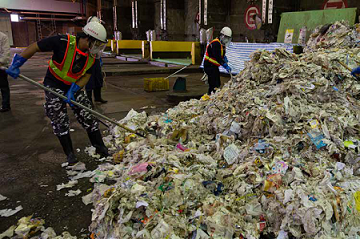
The staff of Beitou's incineration plant in Taipei randomly check on piles of trash for recyclable materials before they are sent to be burnt.
“In the early days, regulations at incineration plants were not as strict. We later heard that incinerators sent back trash to its county of origin because there were recyclable materials mixed in the trash. So, we started to communicate with our residents and urged them to sort their waste,” expressed an environmental official of Kimnen County, an offshore island that has long been shipping its trash to the island of Taiwan. In 2017, Kinmen County was determined to enforce the sorting of waste. Waste collectors would randomly inspect bags of garbage as they collected waste to make sure that residents sorted their garbage. In addition, every day after collecting waste, the collectors would dump all of the bags of trash on the ground and check every single bag to sort out recyclables and food waste—a process that took them 3 to 4 hours daily to complete. One month later, the trash generated in Kinmen was reduced by 46%. Now, waste collectors don't need to check each bag of trash anymore; they just need to pay more attention when collecting garbage from residents.
In addition to thorough inspections, educating residents is also important, as exemplified by Nantou's Zhushan Township, which achieved the highest recycling rate of all of Taiwan for 4 consecutive times. When Zhushan's current mayor Chen Tung-mu (陳東睦) served as the head of the township's waste collecting team, the team often promoted the sorting of waste in schools and communities. “Sometimes, the residents would slack off, so we'd organize large events with activities to remind them of the importance of sorting waste. We'd also hold some fairs at the landfill, so people know where their waste goes after collection,” Chen said.
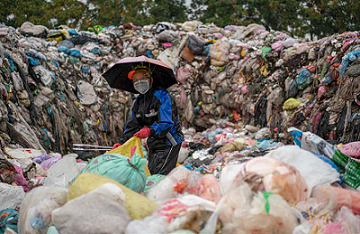
On a cold, rainy day, a waste collector in Zhushan Township's garbage dump sorts piles of garbage to separate recyclables from trash.
On the day we interviewed the waste collectors in Zhushan, it was raining. At the garbage dump, the ground was muddy and slippery, and there was a staff member wearing a small umbrella hat on his head. He was sorting waste in the piles of garbage. He Xiao-long (何曉龍), the current head of the local waste collecting team, explained. “This garbage pile comes from the dumpsters in the mountains, where residents don't sort their garbage thoroughly. To prevent trash from being sent back by incinerators for having recyclables mixed in, we sort them beforehand.”
Waste management varies according to each region's different circumstances, but to really make a difference in reducing trash, it takes action from all parties. Are Taiwan's central and local governments determined to implement effective policies and impose stricter regulations? And are we, as individuals, willing to sacrifice some convenience and sort our waste thoroughly before disposing them? There is much that can be done, and it's up to all of us.
Contact Us | Plan a Visit | Donate
8 Lide Road, Beitou 11259, Taipei, Taiwan
886-2-2898-9999
005741@daaitv.com
©Tzu Chi Culture and Communication Foundation
All rights reserved.
